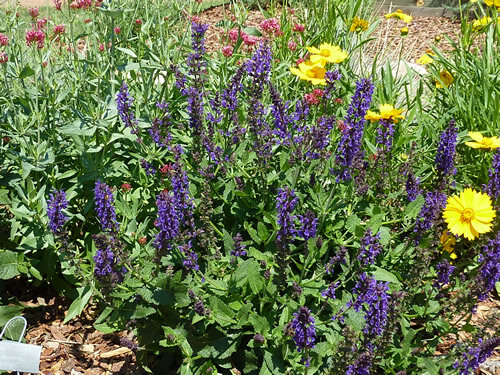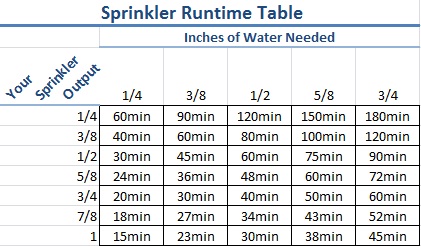It is possible to keep a healthy landscape and conserve water as well.
Determining your lawns needs and your sprinkler output is the first place to start.
There are also several resources to obtain information and ideas in the form of books, websites and local gardens. Xeriscaping is more than rocks and mulch!
Please use the tabs blow to learn more.

HOW MUCH WATER DOES YOUR BLUEGRASS NEED?
This article was reprinted with the permission of Colorado Springs Utilities (CSU). Our thanks to CSU and we hope it helps you.
The high, dry climate of Colorado Springs makes it tough to keep Kentucky Bluegrass green, but maintaining a good-looking lawn doesn’t have to mean applying excessive amounts of water.
MONTHLY WATERING NEEDS IN INCHES PER WEEK:
Jan/Feb: ¼” Jun: 1 ¼ Oct: 7/8”
Mar/Apr: ½” Jul/Aug: 1 ½” Nov: 3/8”
May: ¾” Sep: 1 3/8” Dec: ¼”
Kentucky Bluegrass thrives on far less water than the average homeowner applies to it. Bluegrass only needs water every two or three days, not every day! Watering deeply and less often results in a healthier lawn with a deeper root system. Three easy ways to give your bluegrass the exact amount of water it needs are described below.
Residential Lawn Watering Guidelines
Method 1. Watering by CSU’s Lawn Watering Guidelines (formerly ET)
This is the most scientifically accurate way to irrigate your bluegrass. This method is best for homeowners who have access to the daily newspaper or the web and are willing to vary their irrigation schedules, as needed every two to three days.Remember, the irrigation requirements published in the Gazette are for Colorado Springs, and reflect the recent rain history in the city, not in the Donala District.
1. Determine your sprinkler’s output rate in inches per hour using the Sprinkler Output Worksheet below.
2. Look up the Lawn Watering Guidelines, published daily in The Gazette on the weather page, as well as on Colorado Springs Utilities’ website here, to find out how much water you need to apply to your lawn today.
3. Use the Sprinkler Runtime Table, to find out how long to run your sprinklers by matching your sprinkler’s output rate (step 1) with the amount of water you need to apply to your lawn today in step 2.
4. Run your sprinkler for the number of minutes indicated in the Sprinkler Runtime Table in step 3.
SPRINKLER OUTPUT WORKSHEET
To measure sprinkler output:
1. Set out 6 identical straight-sided cans,
placing them between sprinkler heads and
the edges of their farthest watering patterns.
2. Run your sprinkler for 10 minutes.
3. Pour all the water collected in the cans into one can.
4. Measure and record the depth of the water.
This is your sprinkler’s output rate in inches per hour.
5. If you use several different types of sprink-
Lers to water your bluegrass, or have an auto-
matic sprinkler system with more than one
zone, repeat this process for each sprinkler
type or zone.
6. Record your output rates for future reference.
My Sprinkler Output Rate in Inches per Hour:
Zone 1: _____ Zone 2: _____ Zone 3: _____
Zone 4: _____ Zone 5: _____ Zone 6: _____
Zone 7: _____ Zone 8: _____ Zone 9: _____
Zone 10: _____ Zone 11: _____ Zone 12: _____
Method 2. Watering by Resetting Your Sprinkler’s Timer Every Month
This is a good, scientific way to irrigate your bluegrass. This method is best for homeowners who don’t have time to look up the Lawn Watering Guidelines every few days, but do have time to look up and vary their lawn watering schedules once a month.
1. Determine your sprinkler’s output rate in inches per hour using the Sprinkler Output WorksheetfromMethod 1, above.
2. At the beginning of each month, find out how much water your bluegrass needs each week from the Monthly Water Needs chart at the beginning of this article.
3. Divide the amount of weekly water your bluegrass needs (step 2) by the number of times you want to water your lawn each week. (Watering two or three times a week is sufficient.)
4. Use the Sprinkler Runtime Table from Method 1 above to find out how long to run your sprinklers.
5. Run your sprinklers for the number of minutes indicated in step 4.
Method 3. Watering by the Footprint Test
This is a good way to irrigate your bluegrass. This method is best for experienced gardeners who have time to check the condition of their bluegrass daily, and can water when needed.
1. When your bluegrass holds footprints for more than an hour, it needs to be watered.
2. Determine your sprinkler’s output rate in inches per hour using the Sprinkler Output Worksheet.
3. Use the Sprinkler Runtime Table from method 1 above to determine how long to run your sprinkler.
4. Run your sprinklers for the number of minutes indicated in step 3.
Please note: These methods are applicable only to established bluegrass lawns. They are not suitable for newly sodded or seeded bluegrass lawns. Also, if your lawn is on clay soil, you may find that water is running off when you irrigate as directed. In that case, you may want to apply half the amount of water needed in one cycle, and apply the other half 30-60 minutes later, after the first half has had a chance to soak in. If your lawn is on extremely sandy soil and browns when irrigated as directed, the water is draining away too rapidly, and you may want to water more often.
Download our DONALA PLANT SELECTION GUIDE today!
XERISCAPE RESOURCES
Books
Xeriscape Plant Guide, Fulcrum Publishing
The Xeriscape Handbook, Gayle Weinstein, Fulcrum Publishing
Xeriscape Colorado, the Complete Guide, Connie Lockhart Ellefson & David Winger,Fulcrum Publishing
The Undaunted Garden, 2nd edition, Lauren Springer Ogden, Fulcrum Publishing
Durable Plants for the Garden, Fulcrum Publishing
Native Plants for High-Elevation Western Gardens, Jan Busco & Nancy Morin, Fulcrum Publishing
Waterwise Landscaping with Trees, Shrubs and Vines, Jim Knopf, Chamisa Books
The Xeriscape Flower Gardener, Jim Knopf, Johnson Publishing Company
Plant Driven Design, Scott Ogden & Lauren Springer Ogden, Timber Press
Passionate Gardening, Lauren Springer & Rob Proctor
Websites
Donala Water & Sanitation District, www.donalawater.org
Colorado State University Cooperative Extension Services fact sheets,
www.ext.colostate.edu/pubs/pubs.html
Colorado Springs Utilities, www.csu.org/residential/environment/xeri
Parker Water and Sanitation District, www.pwsd.org
Gardens to Visit
Forest Edge Gardens, 12285 Lindsey Lane 80908, open only on July 22,23,24; 10am-4pm, $4 entry fee
Donala Gardens; On Gleneagle between Gleneagle Shops and Peoples Bank
Colorado Springs Utilities Xeriscape Demonstration Garden; 2855 Mesa Road, CS, CO
Cottonwood Creek Park Xeriscape Demonstration Garden, 3920 Dublin Blvd., CS, CO
Denver Botanic Gardens, Denver, CO
Hudson Gardens, Littleton, CO
Horticulture Art Society Garden, Monument Valley Park, Colorado Springs, CO
Other Resources for Protecting Colorado’s Water Supply
El Paso County Environmental Information, including waste disposal/recycling
http://adm.elpasoco.com/Environmental Division/Pages/default.aspx